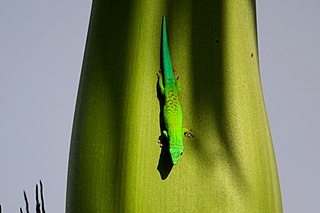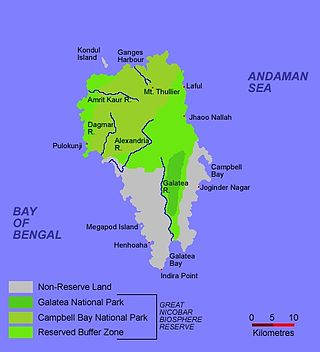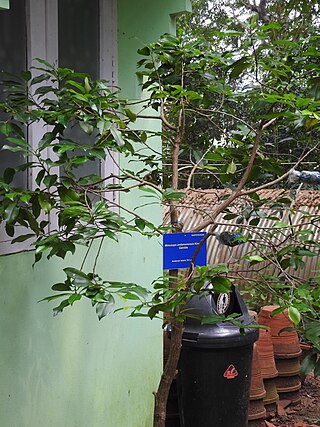
Eulophia, commonly known as corduroy orchids, is a genus of about two hundred species of flowering plants in the orchid family, Orchidaceae. Most Eulophia orchids are terrestrial but some are deciduous while others are evergreen. They either have an underground rhizome or pseudobulbs on the surface and those species with leaves have them on the end of a fleshy stem. The flowers are arranged on a thin flowering spike, the flowers having sepals which are larger than the petals. The genus is widely distributed but most species are found in Africa and Asia, usually growing in shady places with grass or shrubs in forests.

The Andaman day gecko, also known as the Andaman Islands day gecko, is a species of gecko in the genus Phelsuma. It is endemic to the Andaman Islands of India, and has recently been introduced to the Nicobar islands. It is a small, slender lizard, has a bright green colour and feeds on insects. Its range is nearly 5000 km away from the centre of the distribution area of the genus Phelsuma, in Mauritius and Madagascar.

The Great Nicobar Biosphere Reserve encompasses a large part of the island of Great Nicobar, the largest of the Nicobar Islands in the Indian Union Territory of Andaman and Nicobar Islands. The Nicobars lie in the Bay of Bengal, eastern Indian Ocean, 190 km (120 mi) to the north of the Indonesian island of Sumatra. The Reserve has a total core area of approximately 885 km2, surrounded by a 12 km-wide "forest buffer zone". In year 2013 it was included in the list of Man and Biosphere program of UNESCO to promote sustainable development based on local community effort and sound science.

Eulophia andamanensis is an orchid found to occur among the Andaman and Nicobar group of Islands (off the east coast of India and also in the north-western tip of Langkawi island in Malaysia.The occurrence of this ground orchid in Andaman Islands is restricted to some isolated pockets of certain islands and rare. Living collections of this taxon from the Andaman Islands is under ex situ conservation outside the islands at the Field Gene Bank of Jawaharlal Nehru Tropical Botanic Garden and Research Institute, Trivandrum, India. It is a pre-tsunami accession.
The Andaman worm snake is a species of harmless blind snake in the family Gerrhopilidae. The species is endemic to the Andaman Islands. No subspecies are currently recognized.

Boiga andamanensis, known commonly as the Andaman cat snake, is a species of rear-fanged snake in the family Colubridae. The species is endemic to the Andaman Islands.

Bungarus andamanensis, the South Andaman krait, is a species of krait, a venomous elapid snake, which is found in the Andaman Islands of India.

Mount Harriet National Park, officially renamed as Mount Manipur National Park, is a national park located in the Andaman and Nicobar Islands union territory of India. The park, established in 1969, covers about 4.62 km2 (18.00 mi2). Mount Manipur, which is a part of the park, is the third-highest peak in the Andaman and Nicobar archipelago next to Saddle Peak in North Andaman and Mount Thullier in Great Nicobar.
Minervarya andamanensis, commonly known as the Andaman frog, chestnut-brown frog, or Andaman wart frog is a species of frog only found in the Andaman Islands, India. It has been regarded as a synonym of Limnonectes limnocharis, but is now considered a valid species. A related, unnamed species exists in western Thailand.
The Sikkim rat is a species of rodent in the family Muridae.

The Andaman drongo is a species of bird in the family Dicruridae. The species is endemic to the Andaman Islands of the Indian Ocean. There are two subspecies, the nominate race being found across the main islands of the archipelago, and the race dicruriformis occurring on Great Coco Island and Table Island in the north of the chain

The Andaman shrew or Andaman white-toothed shrew is a critically endangered species of mammal in the family Soricidae. It is endemic to the South Andaman Island of India. They are usually active by twilight or in the night and have specialized habitat requirements. Habitat loss due to selective logging, natural disasters such as tsunami and drastic weather change are thought to contribute to current population declines.

Pinanga andamanensis is one of the critically endangered species of endemic palms reported from the Andaman Islands.
Cuapetes andamanensis is a species of shrimp found in the Pacific and Indian Oceans. It was first named by Kemp in 1922.
Ranularia andamanensis is a species of predatory sea snail, a marine gastropod mollusk in the family Cymatiidae.

Pseudocalotes andamanensis is an agamid lizard found on the Nicobar Islands and the Andaman Islands in India. It is also known as the green crestless forest lizard, Andaman and Nicobar forest lizard, Andaman lizard, or Andaman green calotes. This species is an almost exclusive canopy dweller, and is rarely seen.

Pterolophia is a genus of longhorn beetles of the subfamily Lamiinae, containing the following species:

Chaetodon andamanensis, commonly known as the Andaman butterflyfish, is a species of marine ray-finned fish, a butterflyfish belonging to the family Chaetodontidae. It is native to the Indian Ocean.

Mimusops andamanensis is a species of plant in the family Sapotaceae. It is native to Sri Lanka and the Andaman Islands.













